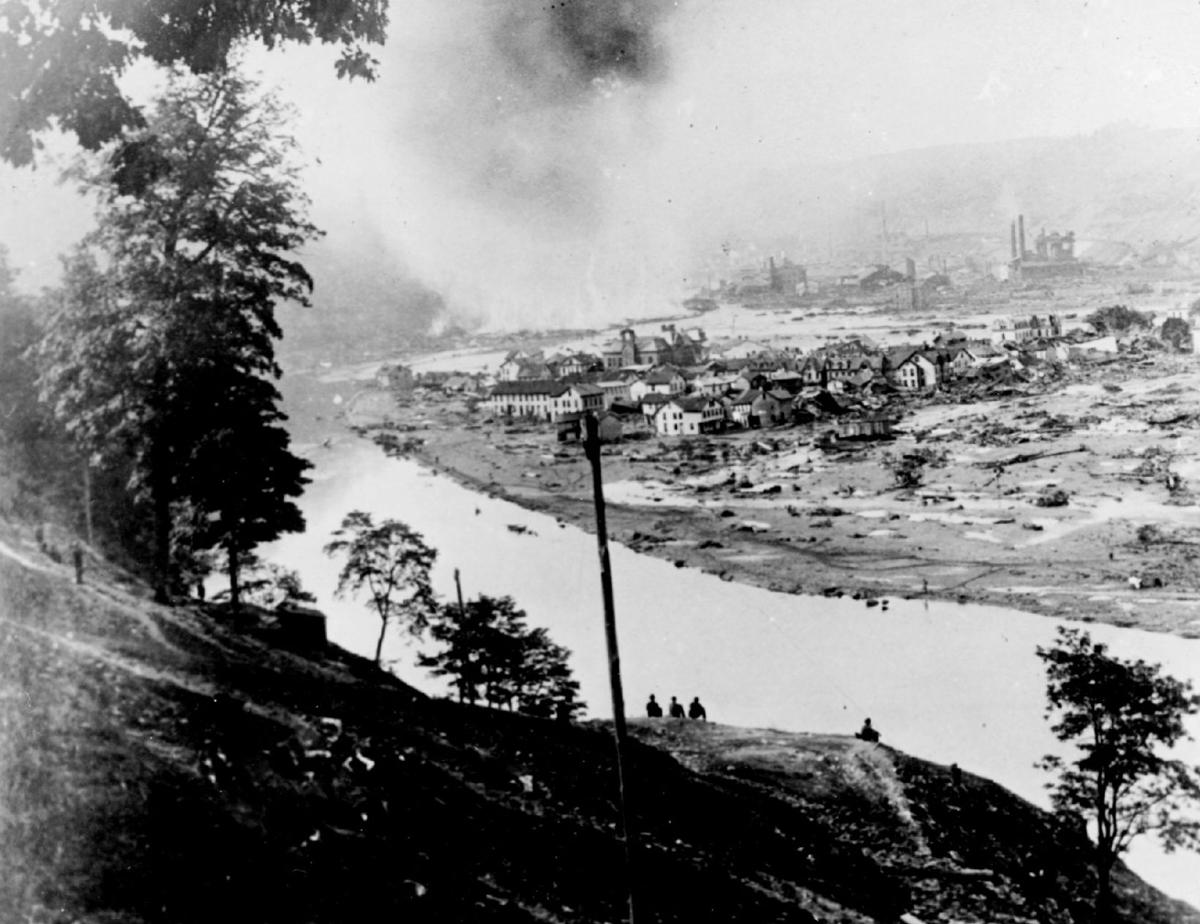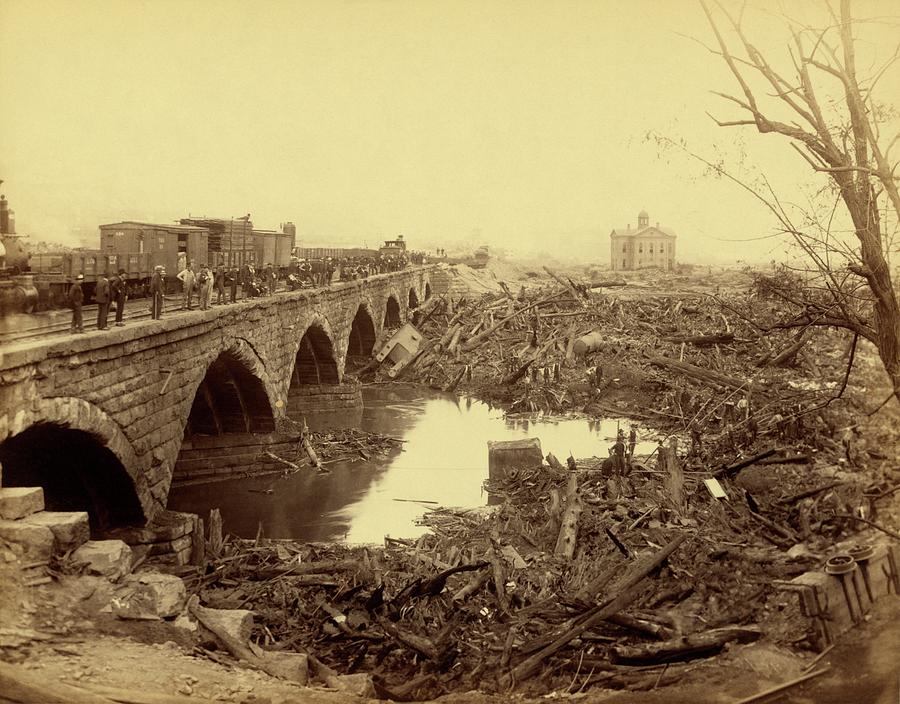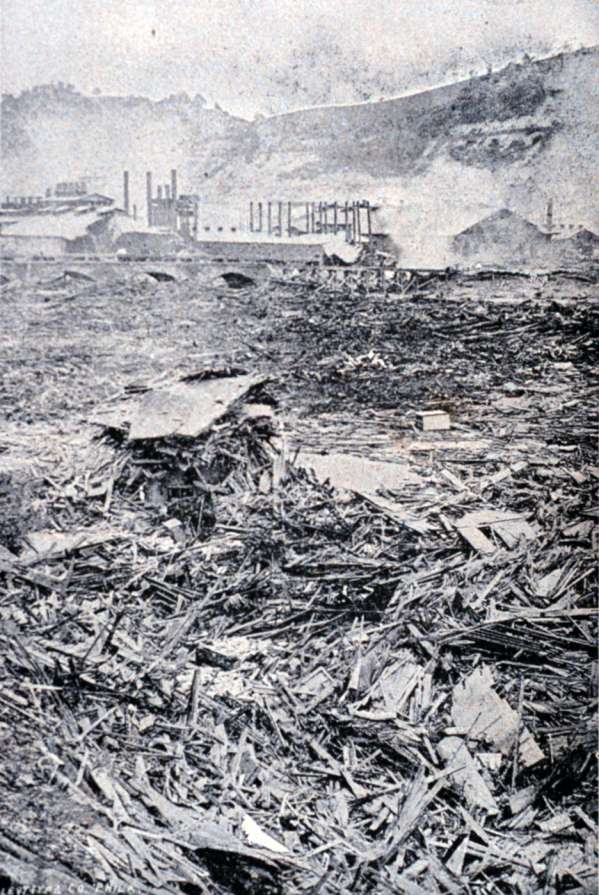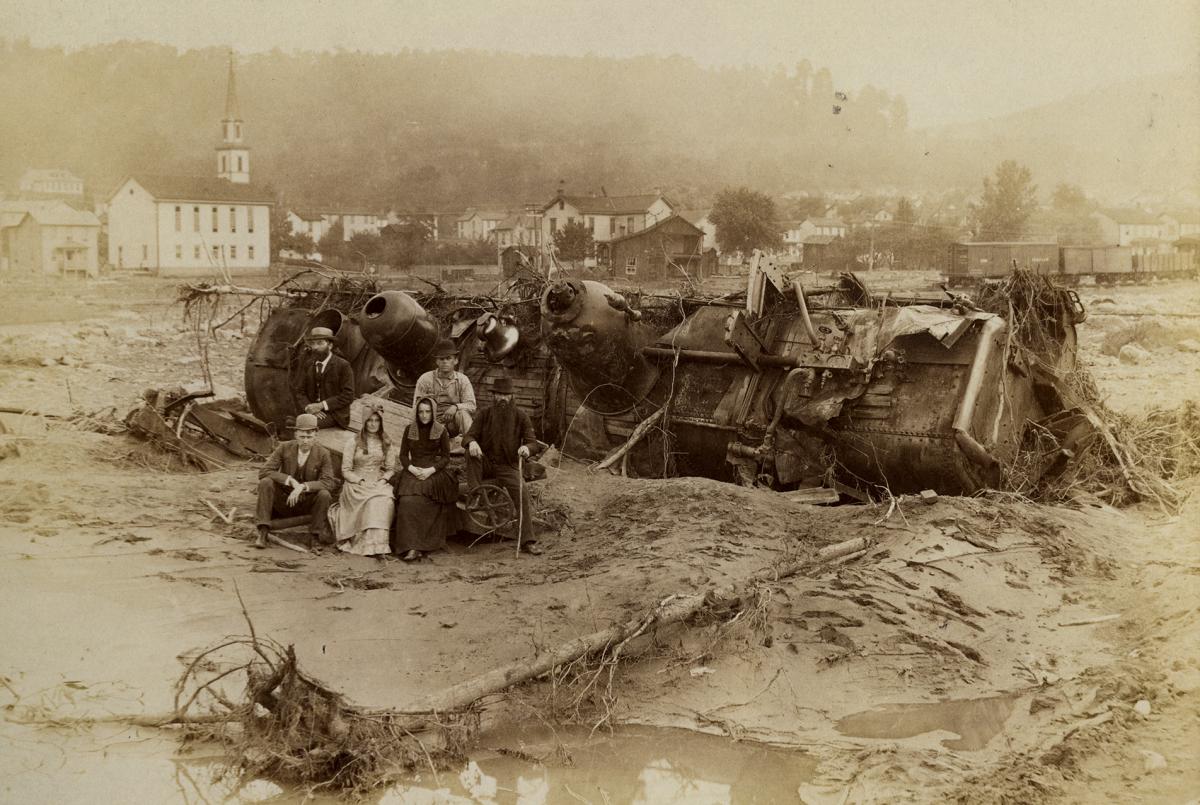Monday, May 31, 2021
Memorial Day, 1889
-4:15 P.M.
Modern dam-breach computer modeling reveals that it took approximately 65 minutes for most of the lake to empty after the dam began to fail.
-4:09 P.M.
-4:07 p.m.
...the flood hit Johnstown. The residents were caught by surprise as the wall of water and debris bore down, traveling at 40 miles per hour (64 km/h) and reaching a height of 60 feet (18 m) in places.
-4:05 P.M.
It was now not quite an hour since the dam had given way. The rain was still coming down, but not so hard as before, and the sky overhead was noticeably brighter.
In Johnston the water in the streets seemed actually to be going down some. It had been a long, tiresome day in Johnstown, and the prospects for a night without gas or electricity were not especially cheerful, but by the looks of the water and the sky, the worst of it had passed. (McCullough 128)
-3:32 P.M.
But within seven minutes, the viaduct collapsed, allowing the flood to resume its course. However, owing to the delay at the stone arch, the flood waters gained renewed hydraulic head, resulting in a stronger, more abrupt wave of water hitting places downstream than otherwise would have been expected. The small town of Mineral Point, one mile...below the Conemaugh Viaduct, was the first populated place to be hit with this renewed force. About 30 families lived on the village's single street. After the flood, there were no structures, no topsoil, no sub-soil – only the bedrock was left. The death toll here was approximately 16 people. In 2009, studies showed that the flood's flow rate through the narrow valley exceeded 420,000 cubic feet per second (12,000 m3/s), comparable to the flow rate of the Mississippi River at its delta, which varies between 250,000 and 710,000 cu ft/s (7,000 and 20,000 m3/s).
...when this second dam let go, it did so even more suddenly and with greater violence that the first one. The bridge collapsed all at once, and the water exploded into the valley with its maximum power now concentrated again by the [six minute] delay...(McCullough 109)
...when the flood came, the wall of water swept through in such a way that it left almost nothing to suggest that there had ever been such a place as Mineral Point. The town was simply shaved off, right down to the bare rock. (Supra 111)
-3:25 P.M.
At the Conemaugh Viaduct, a 78-foot (24 m) high railroad bridge, the flood was momentarily stemmed when...debris jammed against the stone bridge's arch.
It was here...that the water smashed into its first major obstacle, a tremendous stone viaduct...built more than fifty years earlier...
The viaduct was one of the landmarks of the country. It stood seventy-five feet high...Even the biggest locomotives looked tiny by contrast as they chugged across it on their way up the mountain.
Now, for [six minutes], Lake Conemaugh formed again some five and a half miles downstream...It gathered itself together, held now by another dam, which however temporary was nonetheless as high as the first one...(McCullough 108-9)
-3:15 P.M.
"At 3:15 the Central Telephone office called the Tribune to say it had been informed by Agent Deckert, of the Pennsylvania Railroad station, that the South Fork Reservoir was getting worse all the time and that the danger of its breaking was increasing momentarily. It is idle to speculate what would be the result if this tremendous body of water--three miles long, a mile wide in places, and sixty feet deep at the breast at its normal stage--should be thrown into the already submerged Valley of the Conemaugh."-Swank.
No need to speculate, Tom, no need a'tall.
-3:10 P.M. May 31, 1889, Lake Conemaugh, South Fork, Pennsylvania
-3:00 P.M.
"At three o'clock the town sat down with its hands in its pockets to make the best of a very dreary situation. All that had got out of reach of the flood that could, and there was nothing to do but wait..."-George T. Swank, editor, Johnstown Tribune.
Tom didn't get the memos, ambiguous though they were.
-Near 3:00 P.M.
-2:45 P.M.
Wilson's last telegraph that the dam "may possibly go" received in Johnstown by ticket agent Deckert. Thirty minutes away from breaking...
-2:33 P.M.
Wilson's cool, ambiguous last telegraph was received in East Conemaugh. The dam was forty-two minutes from breaking.
-2:25 P.M.
-1:52 P.M.
-12:55 P.M.
-12:30 P.M.
-Between Noon and One O’Clock
The wires being down beyond Mineral Point, Pickerell "waited and waited" for someone to come past who could hand deliver his message to the next station over, East Conemaugh.
A railroad worker finally came by, Pickerell gave the message to him. The railroad worker gave it to his foreman at Buttermilk Falls who had the message sent by telegraph to East Conemaugh, Johnstown and to Robert Pitcairn's office in Pittsburgh. The message was received at those places between noon and one o'clock. (Ibid 93-95)
-Noon, Johnstown
-11:30 A.M., Lake Conemaugh
-11 A.M. Johnstown, Lake Conemaugh
-10 A.M., Johnstown
-9:55 A.M., Lake Conemaugh
-9:30 A.M., Johnstown
About then the rain started coming down again as hard as it had during the night, heavy and wind-driven...For another half-hour he and the boys set about placing his papers and other things well above the flood line of 1887, which was about a foot from the floor. (Ibid 81)
-8:30 A.M., Lake Conemaugh
-6:30 A.M., Lake Conemaugh
The hard, cold rain that had started coming down the night before had eased off considerably by the morning of Friday, May 31. (McCullough p.79)
-May 31, 6 A.M., Johnstown
...it was not until its center was over the eastern slope of the Alleghenies that its effects became destructive. There the storm was held up by winds from the southeast, the Lake region, and a storm from the northeast, the cold wind from the Lakes apparently wringing all the moisture out of the clouds.
Again this morning there had been a bright frost in the hollow below the dam, and the sun was not up long before storm clouds rolled in from the southeast. (McCullough p.19)
-May 31, morning, Cambria County, Pennsylvania
On May 31, the headwaters of the West Branch [of the Susquehanna River] were running twelve feet deeper than ever before.
###
Everywhere on that day the rain is described as coming down not in drops, but in "sheets," in "cloudbursts," in "masses." (McMaster 211)
(some indefinable object: May 30, Johnstown; "The cloud looked square-shaped, like a house with its lower portion surrounded by a white cloud looking like steam, which seemed to rise from all around the main dark cloud," May 28, Kansas)
The mountain top is a broad plane and had never, within the recollection of any man, been visited by such a storm as that of the night of May 30th. (McMaster 222)*
*The nature of the Great Storm of 1889 is amply attested by the vivid descriptions of those who experienced it in Kansas and in Cambria County, and by the record evidence of its effects. I unnecessarily qualify the following with, “I did not experience the Great Storm personally, and; I am not a meteorologist, either professional or amateur":
In my sixty-six years of life, including twenty-some in Western Pennsylvania, which included seeing personally the effects of the "Storm of the Century" that caused the Johnstown Flood of 1977; in addition, experiencing first-hand six months later the Great Blizzard of 1978 in Boston; and in addition, having read a normal amount over the course of a life of comparable years of other storms in the news, the behavior of this storm is unique. I am unaware of any other storm that made such strange sensory impressions on people who experienced it, that was of such maniacal and enduring ferocity, and which formed over and visited its violence upon a landmass of an entire continent. The water deposited on Cambria County by this unique storm was added to the 20,000,000 tons of water ineffectually held back by a derelict earthen dam in Lake Conemaugh. -BH
Sunday, May 30, 2021
-After 10 P.M.. Johnstown
-10 P.M., Johnstown
But an hour or so later it started pouring and there seemed no end to it. "Sometime in the night," according to [Reverend] Chapman, "my wife asked if it were not raining very hard, and I being very sleepy, barely conscious of the extraordinary downpour simply answered, 'Yes,' and went to sleep, thinking no more of it until morning." (Ibid 34)
There were also “weird and unnatural occurrences” reported. The Heidenfelter family: a “rumbling, roaring sound” that seemed to come from some indefinable object not far from their house. It was then followed by a terrific downpour, which, according to Mrs. Heidenfelter, sounded as if a gigantic tank tub had opened at the bottom and all the water dumped out out at once.
“I never heard anything like it in my life. I wanted my husband to get up and see what the matter was, but it was dark and he could have done no good. In the morning, as soon as we could see, the fields were covered with water four or five feet deep . People say the noise we heard was a waterspout…
Apparently the storm did tear big holes in the ground near the Heidenfelter farm…other families close by the lake reported hearing sounds much like thunder but which they were certain were not thunder.” (Supra 88)
(See May 28 Kansas for similar description.)
-9 P.M., Johnstown
At about nine the rain began again, gentle and quiet as earlier. (McCullough p.36)
-7 P.M., Cambria County
By evening [rain] had spread westward as far as the Panhandle of West Virginia and northward to Cleveland. Winds from the ocean and wind from the south forced this storm into a small mountainous area of Pennsylvania where the Allegheny Mountain prevented it from going toward Pittsburgh.
-4 P.M. Johnstown, Pennsylvania
When the rain started coming down about four o'clock, it was very fine and gentle, little more than a cold mist. Even so, no one welcomed it. (McCullough p.33)
-May 30, Afternoon. Cambria County, Pennsylvania
The West Branch of the Susquehanna [River] was flooded by the afternoon of May 30, and the water continued to rise until Saturday, June 1.
The West Branch rises on the west side of the Alleghenies in northwestern Cambria County...The flood waters of the West Branch, Penn's Creek, and the Juniata drained the eastern slopes of the Alleghenies. In the west, the Clarion River, Red Bank Creek, and the Conemaugh rise highest in the Alleghenies and fall the fastest and steepest. A typical mountain stream, the Little Conemaugh, and its principal branch, the Stonycreek, wind through the mountains for twenty-five miles...At the confluence of the Little Conemaugh and the Stonycreek lies Johnstown, which in 1889 comprised a cluster of a dozen boroughs with a population of twenty-five thousand.
-May 30, 6 A.M. East Coast
such was the distribution of pressure over the Atlantic...that, on the morning of the 30th, the winds were blowing steadily from the south and east. (John Bach McMaster, The Johnstown Flood, 210 (1933.)
1889, May 30
This storm had split into two parts as it entered the Mississippi Valley; one part turned north to pass over the Great Lakes and crossed to New England; the other part drifted across Kentucky and Tennessee, where, aided by a southeast wind, the rain moved northward.
Saturday, May 29, 2021
COVID-19 BIDEN+129 (May 29)
Tale of Two Miseries
The Miami “Heat” were humiliated tonight.
In the Magic City the Milwaukee "Male Deer" completed a four games to zero finger-flick of the “Heat,” who just last June had made MIL their does four games to uno.
Only one game in this series was close, the first, a 109-107 win in overtime in Beer. The next three games Miami lost by:
34
29
17
Both of my favorite pro sports teams have questions to answer going into the offseason. For City, do they need a true 9? Do they need to get bigger? Does Pep have to tweak tiki-taka? Thomas Tuchel figured City out in his half year with Chelsea. He has now beat them three straight, denying them the FA Cup in the first and the Champions League trophy today. And Ole Gunnar Solskjær has figured City out crosstown at RayJay. Solskjær has beaten City three straight times at Etihad Stadium. Manchester "Buccaneers" were runners-up to City in the Premier League in the season just ended. Tiki-taka is not the Theory of Relativity; folks can wrap their heads around it, and they are doing so.
For the "Heat" the questions are, in the details, similar to those of Manchester City: do they need a true 5?; do they need to get bigger overall?; do they trust Bam Adebayo enough to give him a max contract? City's decision to let Sergio Aguero walk is, at immense stretch, arguably comparable, at least in angst; does Spo's positionless basketball, like Pep's tiki-taka, need a rework?
But the forest must not be missed for telescoping on trees. There is a systemic question for Miami to answer that City does not have: Does the very identity of the franchise, Pat Riley and the "Culture," need to change? As I keep reminding, the "Heat" is an average (double entendre) .529 in the seven seasons since LeBron James left. Riley eschews draft picks for aging, often troubled and troublesome veterans. They don't have two of the three superstars the c.w. holds an NBA team needs to win a championship, they have one star, minus the super, and a one-year all-star reserve who was uncomfortably passive at the end of the regular season and in this four-game debacle. Milwaukee outrebounded Miami tonight 56-40. 56-40! And Bam had a great stat line, 20 pts, 14 boards. Bam's great game on paper didn't come close to getting the "Heat" even close.
There's puzzling history: the "Heat" has played a putrid (11-30) first half of the season and then a scorching second half (30-11); a blazing first half (24-9) and a skidding second half (10-11 (last season before COVID canceled it)), followed by a bubbly playoff run all the way to the Finals. Why this Dr. Jekyll and Mr. Hyde?
How serious was the Jimmy-Spo contretemps? Shams Charania reported that there were also tensions among players. Jimmy did call out (with plausible deniability) Bam this winter. Spo tried to feature Bam in a leading role in an early-season game, calling an iso for him with the game on the line in the closing seconds. Bam made the basket, dribbling a few times like a guard and hoisting a 10-foot jumper. That was not the move that Spoelstra--or Butler or Riley--had in mind. They wanted Bam to "impose his will," to “bully" (Jimmy's word at a different point on Bam) his way by backing his man down, back-to-basket, and then dunking or hitting a peep.
Is Jimmy an asshole? He's had relationship issues in Minnesota and Philly. Is Jimmy a problem in the locker room?
The answers to these questions, detailed and systemic, lie in the breast of the aging consigliere who sits alone in his darkened chambers in an increasingly bleak house by the bay, sips his port, and keeps these family secrets close. The local beat writers, intimidated by him, are wary of revealing the secrets they do know and are not exactly Woodward and Bernstein in unlocking those they don't. Manchester City do not have the weight of .529 stealing up on them, now crouching on their chests like the hyena in Snows of Kilimanjaro, growing weightier and weightier until it presses life’s breath out of them. The hyena sits at 601 Biscayne Blvd.
FT Chelsea 1 City 0
HT Chelsea 1 City 0
The Main Event
“Heat” Culture Day
Friday, May 28, 2021
COVID-19 BIDEN+128 (May 28)
14-day changes
Good night sweet princes and princesses.
Mas Trouble
Inter Miami gets MLS-record $2M fine, $2.2M cap hit over Designated Player dealings
1889, May 28. Kansas
Beginning in eastern Kansas and Nebraska on May 28, [the great storm] moved eastward into Illinois, Michigan, Indiana, Kentucky, and Tennessee. Michigan and northern Indiana had snow; New York had frost.
A Times special from Emporia, Kan., reports that a disastrous tornado passed over Clements, Chase County, thirty-two miles west of here, about 4 o'clock [in the] afternoon...but the wires are all down, and no reliable information can be obtained.
John Pantle, conductor of a stock train, who arrived in Emporia at 9 o'clock last night, says he passed through Clements just after the storm, and in plain sight of part of its destruction doings. The cloud looked square-shaped, like a house with its lower portion surrounded by a white cloud looking like steam, which seemed to rise from all around the main dark cloud. As it came through the timber it cut a clean swath apparently destroying everything in its path, and when it struck the Cottonwood River it looked as if it was cutting a path through the river, piling up the water on both sides.
(See May 30, 10 P.M. for strikingly similar descriptions in Cambria County, Pennsylvania.)
One Thing Missing From the Biden Budget: Booming Growth
For all the administration’s focus on transformational policies, it’s not forecasting an outburst of economic potential.
In the assumptions that underpin the administration’s budget, G.D.P. growth is strong in 2021 and 2022 — but strong enough only to return the economy to its prepandemic trend line, not to surge above the trajectory it was on throughout the 2010s.
In 2023, G.D.P. growth falls to 2 percent in the budget assumptions, then to 1.8 percent a year through the mid-2020s. That is lower than the 2.3 percent average annual growth rate experienced from 2010 to 2019.




















































